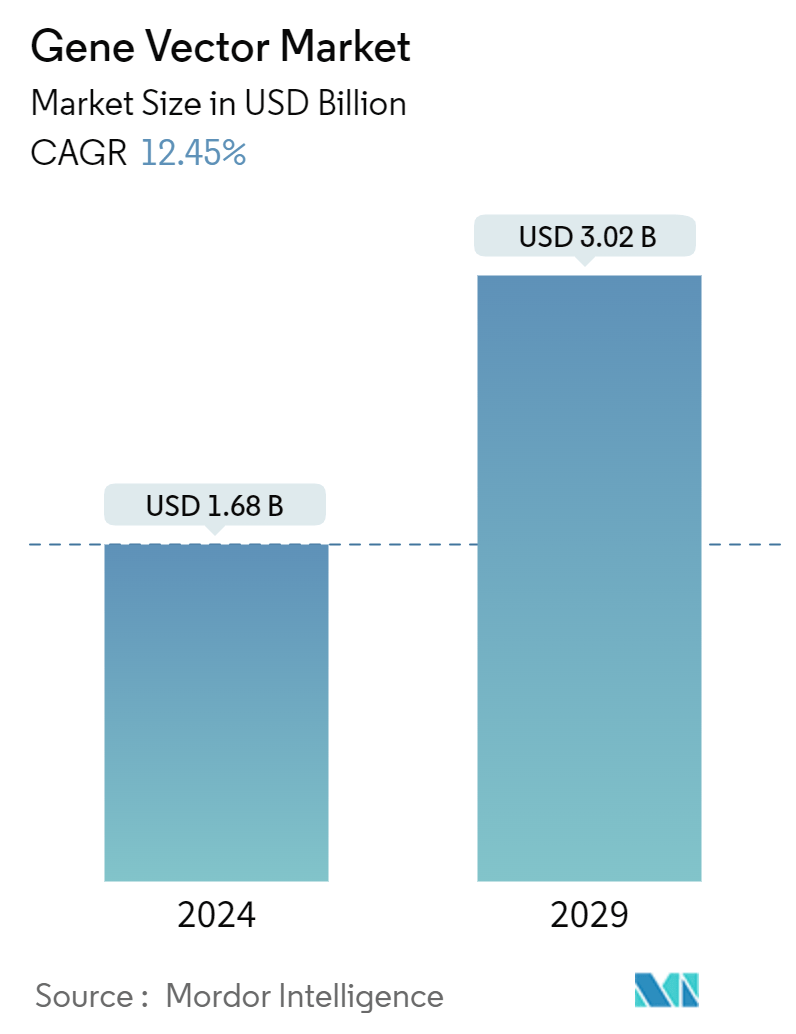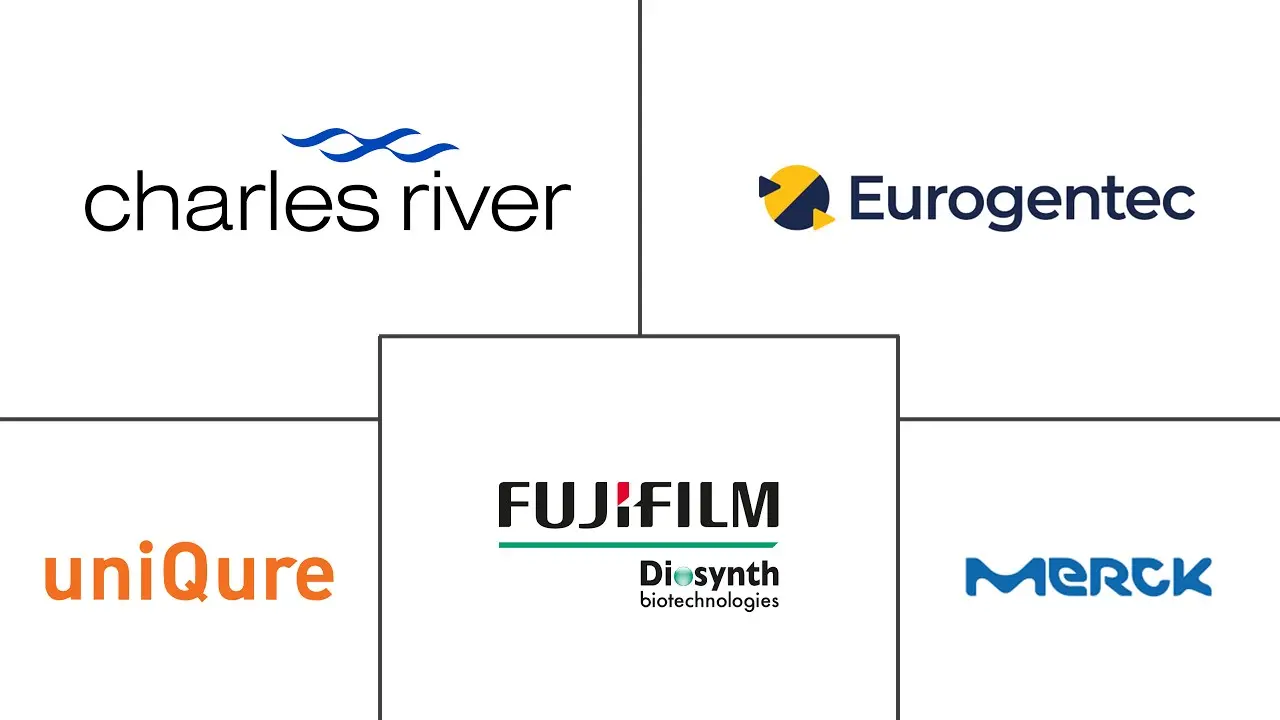
| Study Period | 2019 - 2029 |
| Market Size (2024) | USD 1.68 Billion |
| Market Size (2029) | USD 3.02 Billion |
| CAGR (2024 - 2029) | 12.45 % |
| Fastest Growing Market | Asia Pacific |
| Largest Market | North America |
| Market Concentration | Medium |
Major Players
*Disclaimer: Major Players sorted in no particular order |
Gene Vector Market Analysis
The Gene Vector Market size is estimated at USD 1.68 billion in 2024, and is expected to reach USD 3.02 billion by 2029, growing at a CAGR of 12.45% during the forecast period (2024-2029).
Gene vectors are fundamental tools for transmitting specific genes into host cells. In gene therapy, vectors are often utilized to modify the function of erroneous proteins by adjusting their genetic code. The rapid rise in genetic disorders globally has strongly promoted the demand for gene therapy drugs, necessitating the application of gene vectors to develop and manufacture such drugs. Data from different regulatory bodies indicate the rising number of genetic disorders globally. As per June 2023 data from the Centers for Disease Control and Prevention (CDC), congenital disabilities affected one in every 33 babies (about 3% of all babies) born in the US each year on average. Similarly, as per data from the Australian Institute of Health and Welfare (AIHW), 4,500 (or 1.7%) of Australian babies are born with congenital disabilities each year. The April 2024 data from the European Commission's EUROCAT suggested that genetic anomalies were witnessed in 20.26 cases per 10,000 births in 2022, compared to 19.6 cases per 10,000 births in 2017. With the rising population, the frequency of such defects is also rising, leading to the growing demand for research on gene therapy to tackle such defects. It is directly promoting the application of gene vectors for such research.
Gene therapy's ability to replace or inactivate disease-causing genes enables its application in treating various acquired and genetic diseases. Many gene therapies rely on small, nonpathogenic viruses known as adeno-associated viral vectors (AAVs) to deliver genes into cells. However, very few regulatory body-approved AAV gene therapies are presently available globally, including Elevidys, Hemgenix, Luxturna, Roctavian, and Zolgensma. Hence, with the rising occurrence of genetic disorders, pharmaceutical and biotechnology companies are increasing their research in developing gene therapy drugs, leading to heightened requirements for gene vectors globally. As of January 2024, according to the FDA, more than 900 clinical trials were ongoing in North America's cell and gene therapy sector, while 1,500 trials were ongoing globally, per data from ClinicalTrials.gov, a registry of clinical trials run by the United States National Library of Medicine (NLM). Such a large number of ongoing trials showcase the potential for gene therapy; it is also anticipated to promote the application of gene vectors.
Therefore, owing to the high burden of chronic diseases among the population and growing company activities to increase the development of gene therapy drugs, the market is expected to grow over the forecast period. However, most gene therapy drugs are required to pass through intense regulatory scrutiny, driving the cost of developing and utilizing gene therapy drugs. Such factors hinder gene therapy drug development, leading to lower utilization of gene vectors and thus restraining market growth.
Gene Vector Industry Segmentation
Gene therapy uses genetic material to treat or prevent a specific disease. The objective is to reinstate the normal function of essential proteins in the body by pursuing and counteracting genetic alterations. It aims to improve overall health and proper functioning of the host body of organisms.
The gene vector market is segmented into vector type, disease, application, end-user, and geography. By vector type, the market is segmented into lentivirus, adenovirus, adeno-associated virus (AAV), plasmid DNA, and others. Based on disease, the market is segmented into cancer, genetic disorders, infectious diseases, and others. The gene vector market is segmented by application into gene therapy, vaccinology, and others. Based on end user, the market is segmented into CDMO, CRO, scientific research, and others. By geography, the market is segmented into North America, Europe, Asia-Pacific, South America, and the Middle East and Africa. The report also offers the market sizes and forecasts for 17 countries across the region. For each segment, the market sizing and forecasts were made on the basis of value (USD).
| Consumables | |
| Instruments | Automated Identification & Testing Systems |
| Bioluminescence & Fluorescence-based Detection Systems | |
| Mass Spectrometers | |
| Others | |
| Reagents & Kits |
| Cellular Component-based Testing |
| Nucleic Acid-based Testing |
| Others |
| Clinical Laboratories |
| Food & Beverage Industry |
| Healthcare Facilities |
| Life Science Research & Development Facilities |
| Other End Users |
| North America | United States |
| Canada | |
| Mexico | |
| Europe | Germany |
| United Kingdom | |
| France | |
| Italy | |
| Spain | |
| Rest of Europe | |
| Asia-Pacific | China |
| Japan | |
| India | |
| Australia | |
| South Korea | |
| Rest of Asia-Pacific | |
| Middle East and Africa | GCC |
| South Africa | |
| Rest of Middle East and Africa | |
| South America | Brazil |
| Argentina | |
| Rest of South America |
Gene Vector Market Size Summary
The gene vector market is poised for significant growth, driven by the increasing prevalence of genetic disorders and the rising demand for gene therapy drugs. Gene vectors play a crucial role in gene therapy by facilitating the delivery of genetic material into host cells, thereby enabling the modification of erroneous proteins. The global surge in genetic disorders, as highlighted by data from various health organizations, has spurred research and development in gene therapy, necessitating the use of gene vectors. Despite the promising potential of gene therapy, the market faces challenges due to the stringent regulatory requirements that gene therapy drugs must meet, which can impede their development and utilization. However, ongoing clinical trials and research initiatives continue to underscore the potential of gene therapy, particularly in addressing chronic diseases such as cancer, thereby driving the demand for gene vectors.
North America is expected to lead the gene vector market, supported by robust regulatory frameworks, advanced research institutions, and a strong presence of established industry players. The United States, in particular, benefits from government incentives like the Orphan Drugs Act, which encourages research into rare diseases and boosts the demand for gene vectors. Similar supportive measures in Canada, along with recent approvals of advanced therapeutic products, further contribute to the market's growth in the region. The market landscape is moderately fragmented, with several global and regional companies holding significant market shares. Notable players include Cell Therapy Catapult Ltd, Charles River Laboratories International Inc., and Merck KGaA, among others. These companies are actively involved in advancing gene vector technologies, which are crucial for the development of innovative gene therapies.
Gene Vector Market Size - Table of Contents
1. MARKET DYNAMICS
- 1.1 Market Overview
-
1.2 Market Drivers
- 1.2.1 Rising Number of Infectious Diseases
- 1.2.2 Increasing Adoption by Food & Beverage Industry
- 1.2.3 Growing Government Initiatives
-
1.3 Market Restraints
- 1.3.1 High Initial Investment in Instruments
-
1.4 Porter's Five Force Analysis
- 1.4.1 Threat of New Entrants
- 1.4.2 Bargaining Power of Buyers/Consumers
- 1.4.3 Bargaining Power of Suppliers
- 1.4.4 Threat of Substitute Products
- 1.4.5 Intensity of Competitive Rivalry
2. MARKET SEGMENTATION (Market Size by Value - USD)
-
2.1 By Product Type
- 2.1.1 Consumables
- 2.1.2 Instruments
- 2.1.2.1 Automated Identification & Testing Systems
- 2.1.2.2 Bioluminescence & Fluorescence-based Detection Systems
- 2.1.2.3 Mass Spectrometers
- 2.1.2.4 Others
- 2.1.3 Reagents & Kits
-
2.2 By Method
- 2.2.1 Cellular Component-based Testing
- 2.2.2 Nucleic Acid-based Testing
- 2.2.3 Others
-
2.3 By End User
- 2.3.1 Clinical Laboratories
- 2.3.2 Food & Beverage Industry
- 2.3.3 Healthcare Facilities
- 2.3.4 Life Science Research & Development Facilities
- 2.3.5 Other End Users
-
2.4 Geography
- 2.4.1 North America
- 2.4.1.1 United States
- 2.4.1.2 Canada
- 2.4.1.3 Mexico
- 2.4.2 Europe
- 2.4.2.1 Germany
- 2.4.2.2 United Kingdom
- 2.4.2.3 France
- 2.4.2.4 Italy
- 2.4.2.5 Spain
- 2.4.2.6 Rest of Europe
- 2.4.3 Asia-Pacific
- 2.4.3.1 China
- 2.4.3.2 Japan
- 2.4.3.3 India
- 2.4.3.4 Australia
- 2.4.3.5 South Korea
- 2.4.3.6 Rest of Asia-Pacific
- 2.4.4 Middle East and Africa
- 2.4.4.1 GCC
- 2.4.4.2 South Africa
- 2.4.4.3 Rest of Middle East and Africa
- 2.4.5 South America
- 2.4.5.1 Brazil
- 2.4.5.2 Argentina
- 2.4.5.3 Rest of South America
Gene Vector Market Research FAQs
How big is the Gene Vector Market?
The Gene Vector Market size is expected to reach USD 1.89 billion in 2025 and grow at a CAGR of 12.45% to reach USD 3.40 billion by 2030.
What is the current Gene Vector Market size?
In 2025, the Gene Vector Market size is expected to reach USD 1.89 billion.


